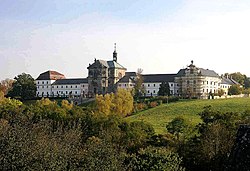Kuks
Kuks | |
|---|---|
Village | |
 Kuks Hospital | |
| Coordinates: 50°24′03″N 15°53′26″E / 50.40083°N 15.89056°E | |
| Country | Czech Republic |
| Region | Hradec Králové |
| District | Trutnov |
| Little District | Dvůr Králové nad Labem |
| First mentioned | 1692 |
| Government | |
| • Mayor | Jiří Beran |
| Area | |
• Total | 4.81 km2 (1.86 sq mi) |
| Elevation | 283 m (928 ft) |
| Population (2019) | |
• Total | 269[1] |
| Time zone | UTC+1 (CET) |
| • Summer (DST) | UTC+2 (CEST) |
| Postal code | 544 43 |
| Website | kuks.cz |
Kuks (Template:Lang-de) is a village in the Czech Republic, Hradec Králové Region, Trutnov District. Its main feature is a baroque spa building with famous sculptures by Matthias Braun.
History
In 1938, it was occupied by the Wehrmacht as one of the municipalities in Sudetenland. The railroad Pardubice-Jaroměř-Trutnov, which goes through Kuks, crossed the newly established border four times within about 40 kilometres (25 mi).[citation needed] After the war, the German-speaking population was expelled in 1945 (see the Beneš decrees) and replaced by Czech settlers.
Spa

On the slope of the Elbe in Kuks, there used to be mineral springs. In 1692–96, Count Franz Anton von Sporck, the owner of the estate, directed three of them at one place and built a simple spa. When the healing effects of the water were proven by professors of the Charles-Ferdinand University and experts from Baden-Baden, Špork enlarged the spa in 1707–22 with an octagonal Church of Holy Trinity, a hospital, theatre and other buildings in the Baroque style. The interiors and exteriors were decorated with Baroque sculptures by Matthias Braun, the most famous of which are the Virtues and Vices. Count Georg Ludwig Albrecht von Rantzau stayed in Kuks (Kukus-Bad) together with two young Dukes, Charles and Anthony Ulrich of Brunswick-Lüneburg, in 1726. In his memoirs, he calls this place the most pleasant and comfortable spa in Europe.[2]
Špork died in 1738 and his heirs were not interested in maintaining the spa. A flood in 1740 destroyed most of the infrastructure and put the spa out of business. The Hospital, Church, and Pharmacy buildings have been preserved, along with historic furnishings, and are considered masterpieces of the Baroque. Braun's exterior sculptures also survive, but have been fast eroding due to the action of water, from rainfall and moisture rising from the ground. For this reason, the Kuks Forest Sculptures were listed in the 2000 World Monuments Watch by the World Monuments Fund.[3] With the financial support of American Express, pump boxes were installed to drive groundwater away from the sculptures and low-lying vegetation was removed to enhance air circulation in the damp wooded environment.
Surrounding
More Baroque statues from Matthias Braun, so-called Bethlehem (Betlém), are in a nearby village of Žireč (part of Dvůr Králové nad Labem). Other places of interest in the area are in Dvůr Králové Zoo) and Jaroměř (fortress).
References
- ^ "Počet Obyvatel v Obcích - Population of Municipalities" (in Czech). Czech Statistical Office. p. 70. Retrieved 28 February 2020.
{{cite web}}: CS1 maint: url-status (link) - ^ Rantzow, George Louis Albert. Mémoires du comte de Rantzow, p. 15 (in French)
- ^ World Monuments Fund - Kuks Forest Sculptures
- Rantzow, George Louis Albert, de (German name Georg Ludwig Albrecht von Rantzau, often named Jørgen Ludvig Albert de Rantzow). Mémoires du comte de Rantzow, vol. 1, Pierre Mortier Amsterdam (1741). First translation ever published by Renate Ricarda Timmermann: Die Memoiren des Grafen von Rantzau, vol. 1, Profund-Verlag (2015), ISBN 978-3-932651-14-4
External links
 Media related to Kuks at Wikimedia Commons
Media related to Kuks at Wikimedia Commons- Official web site of the Kuks municipality (in Czech)
- Official web site of the Kuks Hospital
- Virtual tour of the Kuks Hospital
- Short information on Kuks Hospital in English
- Kuks on a map


